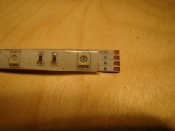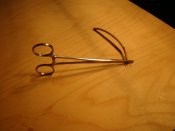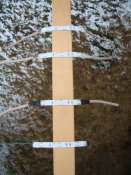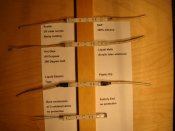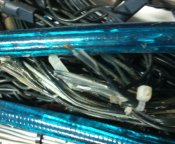Bill Ellick
Full time elf
Appologies if this is in the wrong area. If so, would a mod please move it. I am posting this on a few different forums.
With the advance of the use of RGB lighting it needs to be noted that the sealing of the electrical connections and RGB strips (whether they are encased in a coating or inside a silicone sleeve), there remains a need to seal any open spots to prevent water ingress and potential damage to components or electrical shorts.
Some may think that it is better to leave the connection somewhat open to air so as to let things dry out. I will not make any attempt to debate that here but want to give folks some information on silicone caulks to help prevent troubles later on.
Most people who own homes have used silicone caulk at one time or another to patch up around windows or doors or seal around a tub or shower.
You may be familiar with the nasty vinegar smell that some caulks give off? These types of caulk are ones to stay away from when working with your lights. These are an acid type of cure that is bad for any electrical components and other things as well.
Here is a nice little page from a site in the UK that I found that will give you some better idea on the types of silicone caulks and their usage.
http://www.thewindowman.co.uk/sealants.htm
A typical form of the so called neutral caulk is GE Silicone II. It should be noted that the regular GE or GE I type of caulk is NOT a neutral cure and should not be used.
Of course GE does NOT recommend that silicone caulk of any kind be used on electrical but we tend to work around that for this hobby.
I have not done extensive research on this as of yet, but most silicone caulks even if neutral cure are not really rated for electrical component applications unless you get into the area of RTV type silicone.
This may give you some info on RTV types:
http://www.korsil.ru/content/files/catalog1/rtv_5240%20.pdf
Usually you end up getting into the area of industrial or military RTVs and/or two part potting compounds when looking for safe types of materials for electrical connections and components.
While they are the best, you also will pay a large price for them and that alone may deter most from their usage, especially in something such as a hobby.
I use two part potting compounds for things like permanent connections that I know I will never want to disturb or where there are connections to weatherproof connectors from components.
I think that the relatively cheap GE II, DAP, or some similar style of neutral cure silicone will be more than adequate for connections from RGB strips to wiring leads or strip to strip connections.
Another venue for the neutral cure style of silicone is automotive, marine, and aircraft suppliers (although the aircraft ones will be more than likely very expensive).
Another possible option would be to use a form of plastic epoxy for connections such as Locktite:
http://www.homedepot.com/buy/paint/adhesives-tape/0-85-fl-oz-plastic-epoxy-loctite-54207.html
which you can find from many home center style outlets. I have used this form of epoxy to repair blowmolds with very good results but have yet to try it with any RGB components or electrical connections.
Another problem is that the RGB strips coming from China can have a few different types of coatings on them as well. Some say silicone and some are a resin coating or they use the silicone tubing to encase the strip or have both the tubing and a coating on them.
Whichever type you use will dictate the form and/or type of sealant that you will want to use.
Hopefully someone who is testing out some of the RGB strips can do a testing of different silicones soon to see how they hold up to weather, time, and the elements as well as how they adhere and seal the actual strips as well.
With the advance of the use of RGB lighting it needs to be noted that the sealing of the electrical connections and RGB strips (whether they are encased in a coating or inside a silicone sleeve), there remains a need to seal any open spots to prevent water ingress and potential damage to components or electrical shorts.
Some may think that it is better to leave the connection somewhat open to air so as to let things dry out. I will not make any attempt to debate that here but want to give folks some information on silicone caulks to help prevent troubles later on.
Most people who own homes have used silicone caulk at one time or another to patch up around windows or doors or seal around a tub or shower.
You may be familiar with the nasty vinegar smell that some caulks give off? These types of caulk are ones to stay away from when working with your lights. These are an acid type of cure that is bad for any electrical components and other things as well.
Here is a nice little page from a site in the UK that I found that will give you some better idea on the types of silicone caulks and their usage.
http://www.thewindowman.co.uk/sealants.htm
A typical form of the so called neutral caulk is GE Silicone II. It should be noted that the regular GE or GE I type of caulk is NOT a neutral cure and should not be used.
Of course GE does NOT recommend that silicone caulk of any kind be used on electrical but we tend to work around that for this hobby.
I have not done extensive research on this as of yet, but most silicone caulks even if neutral cure are not really rated for electrical component applications unless you get into the area of RTV type silicone.
This may give you some info on RTV types:
http://www.korsil.ru/content/files/catalog1/rtv_5240%20.pdf
Usually you end up getting into the area of industrial or military RTVs and/or two part potting compounds when looking for safe types of materials for electrical connections and components.
While they are the best, you also will pay a large price for them and that alone may deter most from their usage, especially in something such as a hobby.
I use two part potting compounds for things like permanent connections that I know I will never want to disturb or where there are connections to weatherproof connectors from components.
I think that the relatively cheap GE II, DAP, or some similar style of neutral cure silicone will be more than adequate for connections from RGB strips to wiring leads or strip to strip connections.
Another venue for the neutral cure style of silicone is automotive, marine, and aircraft suppliers (although the aircraft ones will be more than likely very expensive).
Another possible option would be to use a form of plastic epoxy for connections such as Locktite:
http://www.homedepot.com/buy/paint/adhesives-tape/0-85-fl-oz-plastic-epoxy-loctite-54207.html
which you can find from many home center style outlets. I have used this form of epoxy to repair blowmolds with very good results but have yet to try it with any RGB components or electrical connections.
Another problem is that the RGB strips coming from China can have a few different types of coatings on them as well. Some say silicone and some are a resin coating or they use the silicone tubing to encase the strip or have both the tubing and a coating on them.
Whichever type you use will dictate the form and/or type of sealant that you will want to use.
Hopefully someone who is testing out some of the RGB strips can do a testing of different silicones soon to see how they hold up to weather, time, and the elements as well as how they adhere and seal the actual strips as well.


